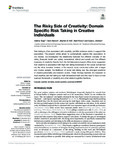The Risky Side of Creativity: Domain Specific Risk Taking in Creative Individuals
| dc.contributor.author | Tyagi, V | |
| dc.contributor.author | Hanoch, Yaniv | |
| dc.contributor.author | Hall, Stephen | |
| dc.contributor.author | Runco, M | |
| dc.contributor.author | denham, susan | |
| dc.date.accessioned | 2017-05-26T08:28:31Z | |
| dc.date.available | 2017-05-26T08:28:31Z | |
| dc.date.issued | 2017-02-03 | |
| dc.identifier.issn | 1664-1078 | |
| dc.identifier.issn | 1664-1078 | |
| dc.identifier.other | ARTN 145 | |
| dc.identifier.uri | http://hdl.handle.net/10026.1/9354 | |
| dc.description.abstract |
Risk taking is often associated with creativity, yet little evidence exists to support this association. The present article aimed to systematically explore this association. In two studies, we investigated the relationship between five different domains of risk taking (financial, health and safety, recreational, ethical and social) and five different measures of creativity. Results from the first (laboratory-based) offline study suggested that creativity is associated with high risk taking tendencies in the social domain but not the other domains. Indeed, in the second study conducted online with a larger and diverse sample, the likelihood of social risk taking was the strongest predictor of creative personality and ideation scores. These findings illustrate the necessity to treat creativity and risk taking as multi-dimensional traits and the need to have a more nuanced framework of creativity and other related cognitive functions. | |
| dc.format.extent | 145- | |
| dc.format.medium | Electronic-eCollection | |
| dc.language | eng | |
| dc.language.iso | en | |
| dc.publisher | Frontiers Media SA | |
| dc.subject | creativity | |
| dc.subject | risk taking | |
| dc.subject | domain specificity | |
| dc.subject | social risks | |
| dc.subject | DOSPERT | |
| dc.title | The Risky Side of Creativity: Domain Specific Risk Taking in Creative Individuals | |
| dc.type | journal-article | |
| dc.type | Journal Article | |
| plymouth.author-url | https://www.webofscience.com/api/gateway?GWVersion=2&SrcApp=PARTNER_APP&SrcAuth=LinksAMR&KeyUT=WOS:000393225100001&DestLinkType=FullRecord&DestApp=ALL_WOS&UsrCustomerID=11bb513d99f797142bcfeffcc58ea008 | |
| plymouth.issue | FEB | |
| plymouth.volume | 8 | |
| plymouth.publication-status | Published | |
| plymouth.journal | Frontiers in Psychology | |
| dc.identifier.doi | 10.3389/fpsyg.2017.00145 | |
| plymouth.organisational-group | /Plymouth | |
| plymouth.organisational-group | /Plymouth/Faculty of Health | |
| plymouth.organisational-group | /Plymouth/Faculty of Health/School of Psychology | |
| plymouth.organisational-group | /Plymouth/REF 2021 Researchers by UoA | |
| plymouth.organisational-group | /Plymouth/REF 2021 Researchers by UoA/UoA04 Psychology, Psychiatry and Neuroscience | |
| plymouth.organisational-group | /Plymouth/REF 2021 Researchers by UoA/UoA04 Psychology, Psychiatry and Neuroscience/UoA04 REF peer reviewers | |
| plymouth.organisational-group | /Plymouth/Research Groups | |
| plymouth.organisational-group | /Plymouth/Research Groups/Centre for Brain, Cognition and Behaviour (CBCB) | |
| plymouth.organisational-group | /Plymouth/Research Groups/Centre for Brain, Cognition and Behaviour (CBCB)/Behaviour | |
| plymouth.organisational-group | /Plymouth/Research Groups/Centre for Brain, Cognition and Behaviour (CBCB)/Brain | |
| plymouth.organisational-group | /Plymouth/Research Groups/FoH - Applied Parkinson's Research | |
| plymouth.organisational-group | /Plymouth/Users by role | |
| plymouth.organisational-group | /Plymouth/Users by role/Academics | |
| dc.publisher.place | Switzerland | |
| dcterms.dateAccepted | 2017-01-20 | |
| dc.identifier.eissn | 1664-1078 | |
| dc.rights.embargoperiod | Not known | |
| rioxxterms.versionofrecord | 10.3389/fpsyg.2017.00145 | |
| rioxxterms.licenseref.uri | http://www.rioxx.net/licenses/all-rights-reserved | |
| rioxxterms.licenseref.startdate | 2017-02-03 | |
| rioxxterms.type | Journal Article/Review | |
| plymouth.oa-location | http://journal.frontiersin.org/article/10.3389/fpsyg.2017.00145/full |


